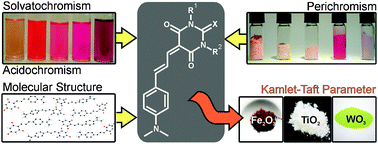Probing the surface polarity of inorganic oxides using merocyanine-type dyes derived from barbituric acid†
Abstract
The solid state complexes, solvatochromic and acidochromic behaviour of four merocyanine-type

* Corresponding authors
a
Department of Polymer Chemistry, Chemnitz Technical University, Strasse der Nationen 62, 09107 Chemnitz, Germany
E-mail:
stefan.spange@chemie.tu-chemnitz.de
Fax: +49 (0) 37 1 53 12 12 39
Tel: +49 (0) 37 1 53 12 12 30
b Department of Physical Chemistry, University of Muenster, Corrensstrasse 28/30, 48149 Muenster, Germany
c Department of Inorganic Chemistry, Chemnitz Technical University, Strasse der Nationen 62, 09107 Chemnitz, Germany
The solid state complexes, solvatochromic and acidochromic behaviour of four merocyanine-type

 Please wait while we load your content...
Something went wrong. Try again?
Please wait while we load your content...
Something went wrong. Try again?
S. Seifert, A. Seifert, G. Brunklaus, K. Hofmann, T. Rüffer, H. Lang and S. Spange, New J. Chem., 2012, 36, 674 DOI: 10.1039/C2NJ20835K
To request permission to reproduce material from this article, please go to the Copyright Clearance Center request page.
If you are an author contributing to an RSC publication, you do not need to request permission provided correct acknowledgement is given.
If you are the author of this article, you do not need to request permission to reproduce figures and diagrams provided correct acknowledgement is given. If you want to reproduce the whole article in a third-party publication (excluding your thesis/dissertation for which permission is not required) please go to the Copyright Clearance Center request page.
Read more about how to correctly acknowledge RSC content.
 Fetching data from CrossRef.
Fetching data from CrossRef.
This may take some time to load.
Loading related content
